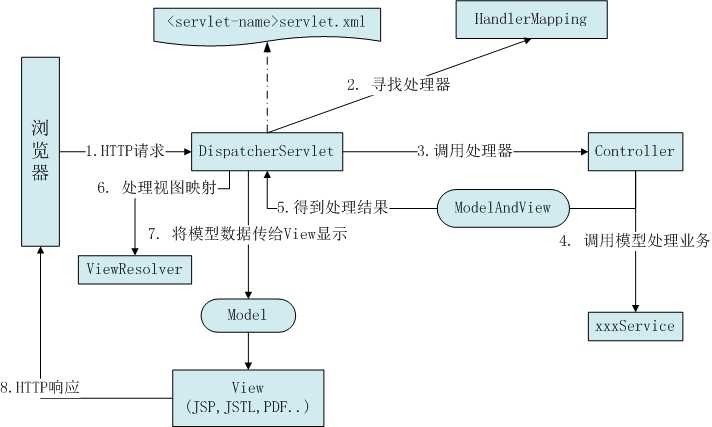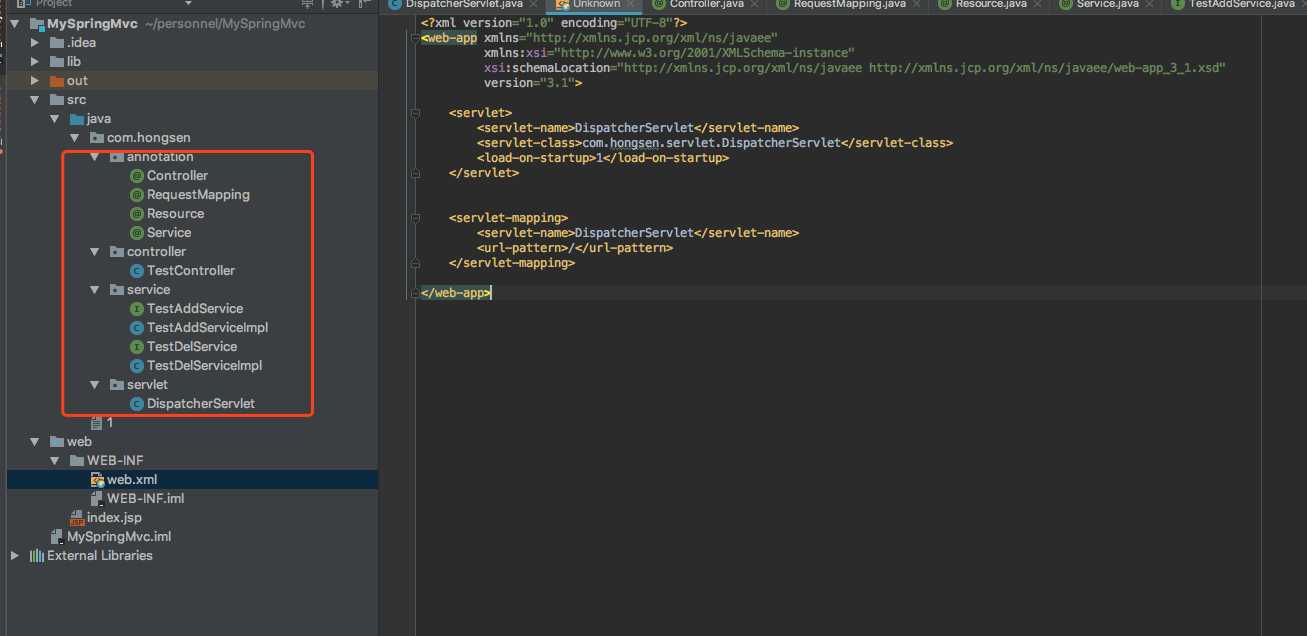标签:tostring 工作 创建 sse context load 生成 stack 集合
一 springMvc核心功能
springMvc是基于分层MVC设计模式的spring实现,他的核心功能是:
1 url跳转
2 ioc
3 aop(本次暂不实现)
二spring工作流程图

三 接下来,让我们写代码实现springMvc框架
通过注解方式实现了跳转和ioc两个核心功能,工程结构如下:

分别创建注解@Controller
package com.hongsen.annotation;
@Target(ElementType.TYPE)
@Retention(RetentionPolicy.RUNTIME)
@Documented
public @interface Controller {
String value();
}
创建@RequestMapping注解
package com.hongsen.annotation;
@Target({ElementType.METHOD,ElementType.TYPE})
@Retention(RetentionPolicy.RUNTIME)
@Documented
public @interface RequestMapping {
String value();
}
创建@resource注解
package com.hongsen.annotation;
@Target(ElementType.FIELD)
@Retention(RetentionPolicy.RUNTIME)
public @interface Resource {
String value();
}
创建@Service注解
package com.hongsen.annotation;
@Target(ElementType.TYPE)
@Retention(RetentionPolicy.RUNTIME)
@Documented
public @interface Service {
String value();
}
创建servlet,代码如下:
package com.hongsen.servlet;
/**
* springMvc 作用
* <p>
* 1 跳转
* 2 ioc
* 3 aop
*
* @author wanghongsen 2018.07.27
*/
public class DispatcherServlet extends HttpServlet {
private static final long serialVersionUID = 1L;
private List<String> classList = new ArrayList<>();
private Map<String, Object> beanInstanceMap = new HashMap<>();
private Map<String, Method> urlHandlerMap = new HashMap<>();
/**
* servlet初始化方法
* 1 scan扫描包路径
* 2 构造所有类集合 (list<String>)
* 3 构造所有bean实例集合 (beanName-> bean)
* 4 构造所有请求handler跳转(uri -> method)
*/
public void init() throws ServletException {
System.out.println("init() start");
String scanBasePath = "com.hongsen";
scan(scanBasePath);
initBeanInstance();
ioc();
initUrlHandlerMap();
}
private void scan(String scanBasePath) {
URL url = this.getClass().getResource("/" + scanBasePath.replace(".", "/"));
String baseFilePath = url.getFile();
File baseFile = new File(baseFilePath);
String[] subFilePaths = baseFile.list();
for (String subFilePath : subFilePaths != null ? subFilePaths : new String[0]) {
File subFile = new File(baseFilePath + subFilePath);
if (subFile.isDirectory()) {
scan(scanBasePath + "." + subFilePath);
} else {
classList.add(scanBasePath + "." + subFilePath);
}
}
}
private void initBeanInstance() {
for (String beanName : classList) {
try {
beanName = beanName.replace(".class", "");
Class beanClass = Class.forName(beanName);
try {
if (beanClass.isAnnotationPresent(Controller.class)) {
Controller controller = (Controller) beanClass.getAnnotation(Controller.class);
beanInstanceMap.put(controller.value(), beanClass.newInstance());
} else if (beanClass.isAnnotationPresent(Service.class)) {
Service service = (Service) beanClass.getAnnotation(Service.class);
beanInstanceMap.put(service.value(), beanClass.newInstance());
}
} catch (InstantiationException | IllegalAccessException e) {
e.printStackTrace();
}
} catch (ClassNotFoundException e) {
e.printStackTrace();
}
}
}
private void ioc() {
for (String beanName : classList) {
try {
beanName = beanName.replace(".class", "");
Class beanClass = Class.forName(beanName);
Field[] fields = beanClass.getDeclaredFields();
for (Field field : fields) {
if (field.isAnnotationPresent(Resource.class)) {
Resource resource = field.getAnnotation(Resource.class);
String val = resource.value();
try {
field.setAccessible(true);
Service service = (Service) beanClass.getAnnotation(Service.class);
if (service != null) {
field.set(beanInstanceMap.get(service.value()), beanInstanceMap.get(val));
} else {
Controller controller = (Controller) beanClass.getAnnotation(Controller.class);
if (controller != null) {
field.set(beanInstanceMap.get(controller.value()), beanInstanceMap.get(val));
}
}
} catch (IllegalAccessException e) {
e.printStackTrace();
}
}
}
} catch (ClassNotFoundException e) {
e.printStackTrace();
}
}
}
private void initUrlHandlerMap() {
for (String beanName : classList) {
try {
beanName = beanName.replace(".class", "");
Class beanClass = Class.forName(beanName);
if (beanClass.isAnnotationPresent(RequestMapping.class)) {
RequestMapping baseReqMap = (RequestMapping) beanClass.getAnnotation(RequestMapping.class);
if (baseReqMap != null) {
String requestBaseUrl = baseReqMap.value();
Method[] methods = beanClass.getMethods();
for (Method method : methods) {
RequestMapping reqMap = method.getAnnotation(RequestMapping.class);
if (reqMap != null) {
urlHandlerMap.put(requestBaseUrl + reqMap.value(), method);
}
}
}
}
} catch (ClassNotFoundException e) {
e.printStackTrace();
}
}
}
protected void doPost(HttpServletRequest request, HttpServletResponse response) throws javax.servlet.ServletException, IOException {
doGet(request, response);
}
protected void doGet(HttpServletRequest request, HttpServletResponse response) throws javax.servlet.ServletException, IOException {
String uri = request.getRequestURI();
String contextPath = request.getContextPath();
String requestUrl = uri.replace(contextPath, "");
Method method = urlHandlerMap.get(requestUrl);
if (method == null) {
return;
}
Class beanClass = method.getDeclaringClass();
Controller controller = (Controller) beanClass.getAnnotation(Controller.class);
Object bean = beanInstanceMap.get(controller.value());
try {
Map<String, String[]> requestParameterMap = request.getParameterMap();
Object[] args = new Object[requestParameterMap.entrySet().size()];
int index = 0;
for (Map.Entry entry : requestParameterMap.entrySet()) {
args[index] = entry.getValue();
index++;
}
method.invoke(bean, args);
} catch (IllegalAccessException | InvocationTargetException e) {
e.printStackTrace();
}
}
}
创建完servlet后web.xml自动生成相应代码
<load-on-startup>加这个标签,tomcat启动时会自动加载指定的servlet 大于等于0时启动tomcat会加载 servlet的init()方法 数字越小代表加载的优先级越高
<url-pattern>/这个标签是tomcat请求扫描路径,扫到后会调用servlet相应的doGet或doPost方法
<?xml version="1.0" encoding="UTF-8"?>
<web-app xmlns="http://xmlns.jcp.org/xml/ns/javaee"
xmlns:xsi="http://www.w3.org/2001/XMLSchema-instance"
xsi:schemaLocation="http://xmlns.jcp.org/xml/ns/javaee http://xmlns.jcp.org/xml/ns/javaee/web-app_3_1.xsd"
version="3.1">
<servlet>
<servlet-name>DispatcherServlet</servlet-name>
<servlet-class>com.hongsen.servlet.DispatcherServlet</servlet-class>
<load-on-startup>1</load-on-startup>
</servlet>
<servlet-mapping>
<servlet-name>DispatcherServlet</servlet-name>
<url-pattern>/</url-pattern>
</servlet-mapping>
</web-app>
创建Controller类
package com.hongsen.controller;
@Controller("testController")
@RequestMapping("/test")
public class TestController {
@Resource("testAddService")
private TestAddServiceImpl testAddService;
@Resource("testDelService")
private TestDelServiceImpl testDelService;
@RequestMapping("/add.json")
public void testAdd() {
testAddService.add();
}
@RequestMapping("/del.json")
public void testDel(Object num1, Object num2) {
testDelService.del(num1.toString(), num2.toString());
}
}
创建service接口和实现类
package com.hongsen.service;
public interface TestAddService {
void add(String num);
}
package com.hongsen.service;
@Service("testAddService")
public class TestAddServiceImpl implements TestAddService{
@Override
public void add(String num) {
System.out.println("add方法执行!");
}
}
部署tomcat启动成功后:
访问:http://localhost:8080/test/add.json

标签:tostring 工作 创建 sse context load 生成 stack 集合
原文地址:https://www.cnblogs.com/wanghongsen/p/9377651.html